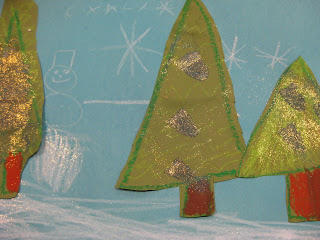Winter Tree Landscape
This week, as the wintry weather returned to Oak Park, we created a seasonal landscape in our art class. We began the class by looking at photos and paintings of evergreen trees in winter. We discussed the difference between coniferous (evergreen) and deciduous trees. There were also miniature evergreen trees on each table for the children to pick up and handle. We introduced the art word "landscape" and talked about what makes a work of art a landscape.
Then we got to work practicing drawing triangles for the trees and rectangles for the trunks, then adding branches and texture with oil pastels. The children cut out their trees, added a blanket of snow to blue paper, and some snowflakes or other decorations of their choosing with white oil pastels on the background.
In the final steps, the children arranged their trees on the paper and glued them down. We talked about how the smaller trees should be behind the larger trees on the paper to make it look like they were farther away. Several of the children understood and tried this technique after just one discussion!
A little bit of glitter was the finishing touch. I think they look great!






































